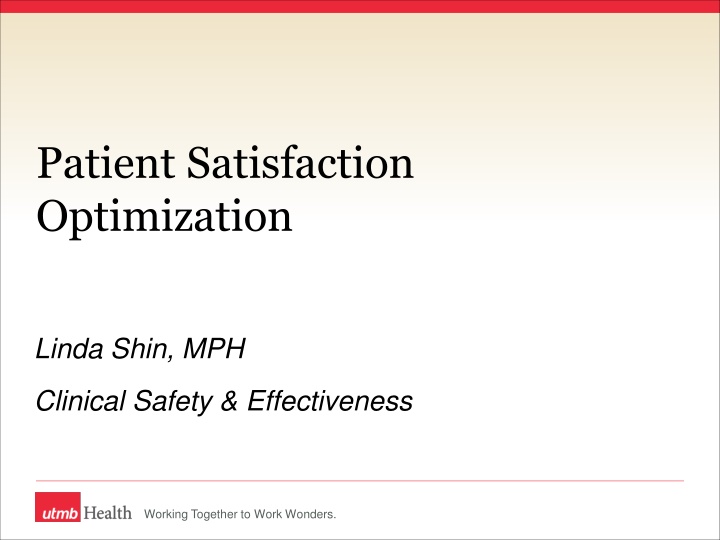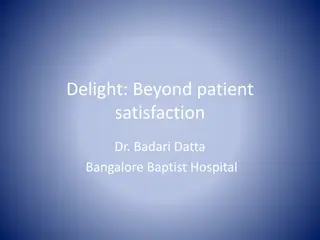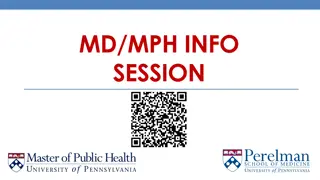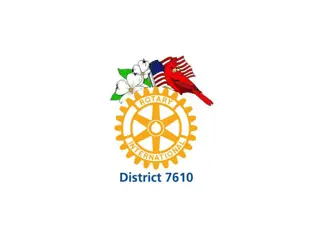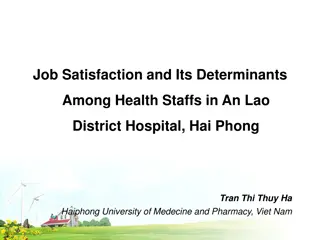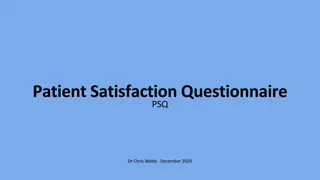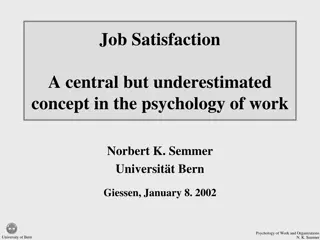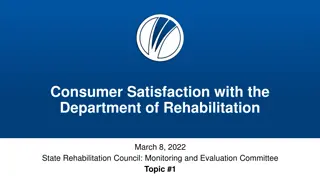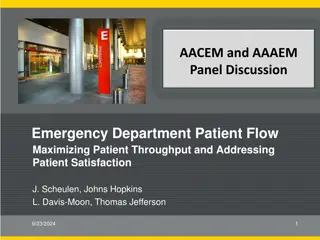Patient Satisfaction Optimization with Linda Shin, MPH
A collaborative team led by Linda Shin, MPH, is working to enhance patient satisfaction levels by targeting areas for improvement, such as blood draws. Through review of survey data and stakeholder input, the team aims to boost satisfaction scores in specific units. They utilize various tools like process mapping, brainstorming, and flow diagrams to achieve their goals effectively.
Download Presentation

Please find below an Image/Link to download the presentation.
The content on the website is provided AS IS for your information and personal use only. It may not be sold, licensed, or shared on other websites without obtaining consent from the author.If you encounter any issues during the download, it is possible that the publisher has removed the file from their server.
You are allowed to download the files provided on this website for personal or commercial use, subject to the condition that they are used lawfully. All files are the property of their respective owners.
The content on the website is provided AS IS for your information and personal use only. It may not be sold, licensed, or shared on other websites without obtaining consent from the author.
E N D
Presentation Transcript
Patient Satisfaction Optimization Linda Shin, MPH Clinical Safety & Effectiveness Working Together to Work Wonders.
Team Members Sponsor: Randy Urban, MD Astrud Leyva, MD Beverly Mizell, RN Corrin Le Vasseur, MPA Deven Barriault, RN Jennifer Zirkle, RN Linda Shin, MPH Lindsay Sonstein, MD Working Together to Work Wonders. 2
Background UTMB measures patient satisfaction levels using Press Ganey surveys Patient satisfaction optimization team reviewed past Press Ganey survey results and identified Blood Draw as an area in need of improvement Working Together to Work Wonders. 3
What Were We Trying To Accomplish? Aim Statement Increase patient satisfaction mean scores by 1.0 point for the Press Ganey question, the courtesy of person who drew blood , for units 9D (Transplant) and 10C (Acute Care for Elders) for July and August 2010. Working Together to Work Wonders. 4
Baseline: Acute Care For Elders (ACE) Unit Working Together to Work Wonders. 5
Baseline: Transplant Unit Working Together to Work Wonders.
Process Mapping Working Together to Work Wonders.
Flow Diagram Working Together to Work Wonders.
Fishbone Diagram Working Together to Work Wonders.
Brainstorm Met with the stakeholders o Nursing Staff o Lab management o All inpatient phlebotomists Reviewed and analyzed patients comments included in Press Ganey survey results Multiple list serve queries o University Hospital Consortium o American College of Healthcare Executives Working Together to Work Wonders.
Matrix of Possible Interventions Ease of Implementation Easy Flyer/tent card with educational Info to give to patients regarding blood draw by phlebotomists Posting Patient Satifaction scores on the units Low Impact/Easy Medium Impact/Easy High Impact/Easy RN explanation of blood draw/education Low Impact/Moderate Role Playing Exercise with Phlebotomists Medium Impact/Moderate PCT & Phlebotomy Coordination High Impact/Moderate Nurse & Phlebotomy AIDET training/Scripting Medium Impact/Difficult 10 PM Blood Draw High Impact/Difficult Low Impact/Difficult Difficult Low Potential Impact High Working Together to Work Wonders.
Project Plan 1. Tent cards (English and Spanish) 2. AIDET training for phlebotomists (Acknowledge, Introduce, Duration, Explanation, and Thank You) 3. Patient education 4. Coordination of vital signs and blood draw on ACE unit Working Together to Work Wonders.
Secondary Interventions 1. Tent Cards Added a note for patients to score us on Press Ganey Laminated the cards Housekeeping, patient advocates, and unit nursing staff were all involved in keeping the tent cards at the patients bedside 2. Patient education was provided during the admission process Working Together to Work Wonders.
Results ACE Unit (92.50) mean = 86.66 mean = 90.26 Working Together to Work Wonders.
Results Transplant Unit (80.71) mean = 85.42 mean = 88.51 Working Together to Work Wonders.
Discussion We found significant differences in the outcomes at these two units. One of the contributing factors was the differences in the patient population. Another may be that the transplant unit was less frequently staffed by UTMB nurses. For future patient satisfaction initiatives, it will be important to have representatives from each specialty to arrive at best solutions and improvement initiatives. Working Together to Work Wonders.
Barriers And Challenges More agency nurses than expected worked on the Transplant Unit Tent cards were thrown away Coordination between PCTs and phlebotomists was not always feasible Delays in obtaining reliable Press Ganey survey results Working Together to Work Wonders.
Next Steps Work with UTMB Organizational Effectiveness, Training, and Recognition departmentto continue AIDET training for all inpatient nurses and new phlebotomists. Work with Patient Services to create appropriate signs/posters for each unit to increase the number of returned surveys. Provide in-service for nurses to educate patients regarding phlebotomy. Recommend to laboratory operations to utilize a standard schedule for phlebotomy activity and to coordinate with other morning activities at each unit. Working Together to Work Wonders.
Return On Investment Year 1 Costs $21, 179 Benefit* --- Annual Net Benefit ($21,179) Cumulative Benefit ($21,179) *Satisfaction leads to patient loyalty, and increased loyalty is the single most important driver of long term financial performance. Jones and Sasser **More frequent blood draws may lead to lower satisfaction level and higher cost Working Together to Work Wonders.
Conclusion We CAN improve our patients satisfaction! Hospital stays are full of surprises and it is important to let patients know what to expect during their stay. Institutions may need specialty- and patient population- specific initiatives to address patient satisfaction. Working Together to Work Wonders.
Acknowledgment Susan Seidensticker Phlebotomy Team Lab Management: Transplant and ACE unit staff Bert Nash Ricardo Segura Theresa Friloux Environmental Services Patient Advocates OETR Tony Armenta Jeanette Mancha Bob Scott and Martha Livanec Working Together to Work Wonders.
Questions? To improve is to change. To be perfect is to change often. - Winston Churchill Working Together to Work Wonders.
